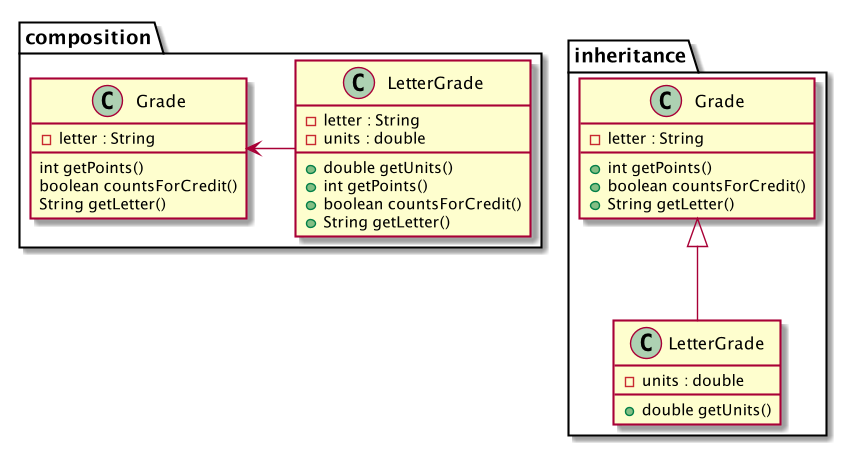
Classes and objects on their own are not too hard to understand. The challenge starts when classes and objects interact with each other.
First of all, let’s discuss how object objects learn about each other:
Of these four methods the first one stand out, as it creates a very tight coupling: The creator object knows exactly what class the created object is. In all the other cases the only information communicated is the interface of the object.
There are numerous mechanisms that allow us to extend the functionality provided by a certain class. The main two mechanisms are the following:
Example. Consider a simple Grade class:
class Grade {
private final String letter;
public Grade(String letter) {
throwExceptionIfInvalidLetter();
this.letter = letter;
}
public int getPoints() { ... }
public boolean countsForCredit() { ... }
public String getLetter() { return letter; }
}We now want to create a UnitGrade class. It needs to allow for both a letter grade and also the amount of units that the class is worth (1, 0.5 etc). We have fundamentally two options for the design of this new class:
The inheritance approach says that we should create a new subclass of the Grade class which also contains a new field, for the units:
class UnitGrade extends Grade {
private final double units;
public UnitGrade(String letter, double units) {
super(letter); // Call Grade constructor
this.units = units;
}
public double getUnits() { return units; }
// countsForCredit is inherited
// getLetter is inherited
public int getPoints() {
return units * super.getPoints();
}
}We use the term extends Grade to indicate that this is a subclass of Grade, and will therefore inherit everything that Grade has. In this instance we automatically get for free the countsForCredit and getLetter methods. We have to modify the implementation of getPoints because it has to take into account the units. We can use the super keyword whenever we have to refer to the superclass.
The composition approach says that we should create a new class that has a grade field in it and a units field in it.
class UnitGrade {
private Grade grade;
private double units;
public UnitGrade(String letter, double units) {
this.grade = new Grade(letter);
this.units = units;
}
// other possible constructor, receiving an external grade
public UnitGrade(Grade grade, double units) {
this.grade = grade;
this.units = units;
}
// Delegations
public boolean countsForCredit() { return grade.countsForCredit(); }
public String getLetter() { return grade.getLetter(); }
public getUnits() {
return units * grade.getUnits();
}
}In this case a UnitGrade instance contains a Grade instance as a field, and it can refer to it for information. In particular, some of the methods of UnitGrade simply return a corresponding call to grade. This is called delegation.
Let’s discuss advantages and disadvantages of the two approaches:
Grade class (maybe some specialized “pass/fail grade subclass”, we cannot do that. In other words, inheritance directly links the two classes. On the other hand with composition, the field grade can belong to any subclass of Grade. Composition allows the specific class that is used to be determined at runtime, and to even change in the lifetime of an application.Essentially, inheritance is a static compile-time source-code dependency between classes, while composition is a dynamic run-time dependency between objects.
In UML notation, these two dependencies are drawn differently: inheritance is a hollow-point arrow, often drawn in a consistent vertical direction, while composition is a filled-point arrow, often drawn in a horizontal direction.

read(), ready(), skip(n), close(). It is actually an abstract class, with a number of implementations. So for this discussion you should think of it more of as an interface.Reader which reads its contents from a provided character array. It is anexample of inheritance, as it inherits some functionality from the abstract class.Reader that reads its input from an “input stream” (like the terminal standard input). It is also an example of inheritance. In order to do its work, it takes as argument to its constructor an InputStream. It is therefore an example of composition as well.Reader. It takes in as input another object in of type Reader, and “buffers” the read input by reading it in specified chunks. It is therefore an example of composition. At the same time, it is also an example of inheritance, as it inherits some functionality from Reader via the subclass relationship. This is an example of a decorator: It both inherits from the Reader class as well as composes from it: It effectively acts as a “decoration” to the existing behavior of some other Reader, rather than directly providing the Reader behavior itself.BufferedReader which further keeps track of line numbers. This is an example of inheritance.PRACTICE: Draw a UML diagram containing all these classes and their relationships.